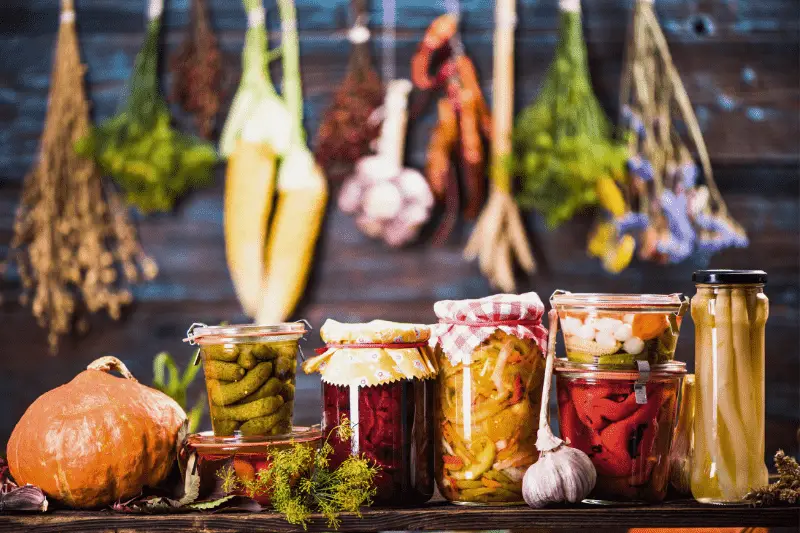Pickling has been a popular method of preserving vegetables for centuries.
It’s an easy and quick way to add flavor to dishes and increase the shelf life of fresh vegetables.
Pickled vegetables are tangy, crunchy, and can be enjoyed as a snack, topping, or side dish.
In this article, we will be discussing how to pickle vegetables for beginners using the quick pickling method.

Quick Pickles vs Fermented Pickles
There are two common methods of pickling vegetables: quick pickles and fermented pickles.
Quick pickles, also known as refrigerator pickles, are vegetables that are soaked in a vinegar-water-salt brine solution and stored in the refrigerator for a few days before being consumed.
They do not require any special equipment or techniques and are ready to eat within hours of making them.
On the other hand, fermented pickles require more time and effort but develop more complex flavors over time.
They involve preserving vegetables in saltwater brine until they undergo natural fermentation by lactic acid bacteria present in the mixture.
Fermented pickled have been linked with various health benefits such as improved digestion and immunity.
Basic Brine Recipe for Quick Pickling
To make quick pickles, all you need is a basic brine made from equal parts vinegar and water.
You can adjust the ratio according to your personal preference or recipe requirements.
Ingredients:
- 1 cup white vinegar
- 1 cup water
- 1 tablespoon salt
- Optional: sugar, spices (such as dill, garlic cloves)
Instructions:
1) In a saucepan over medium heat, whisk together vinegar, water, salt until dissolved
2) Allow mixture to cool completely before pouring into jars over prepped veggies
3) Add spices or other flavorings as desired
4) Seal tightly with lids
5) Store jars in refrigerator until ready
Best Vegetables to Pickle
Almost any vegetable can be pickled, making it a versatile preservation method.
Some popular vegetables for pickling include cucumbers, carrots, beets, green beans, onions, and peppers.
It’s best to choose vegetables that are fresh and firm as they hold up better during the pickling process.
Tips on selecting the best vegetables for pickling:
– Choose vegetables at their peak freshness
– Avoid bruised or limp veggies
– Select small cucumbers or other small veggies to fit better into jars
– Cut larger vegetables into smaller pieces or slices for even absorption of the brine
Prepping Vegetables for Pickling
Before you can pickle your veggies, you’ll need to prep them by washing and chopping them into desirable shapes and sizes.
For example, cucumbers are usually sliced while carrots may be cut into sticks.
Instructions:
1) Wash your veggies thoroughly
2) Remove any stems or leaves as needed
3) Cut your veggies according to preference
4) Pack tightly in jars
Quick Pickling Process
Once you have prepped your veggies and made your brine mixture, it’s time to start pickling!
Instructions:
1) Pour cooled brine mixture over prepped veggies in jars until full
2) Tightly seal jars with lids
3) Allow jars several hours (minimum one hour) in refrigerator before eating
4) Pickles will develop a deeper flavor over 24 hours up to 2 weeks
Long-Term Storage Options: Canning Process
If you want to store your pickles for longer periods beyond refrigeration lifespan of quick-pickles (1-2 weeks), canning is an excellent option.
Canning involves bottling prepared food in sterilized glass jars and then subjecting them through boiling temperatures that kill harmful bacteria present in them.
Instructions:
1). Sterilize glass jars and lids by boiling in hot water for 10 minutes
2). Pack your pickled veggies tightly into sterilized jars
3). Boil vinegar-water brine mixture for 5 minutes, add to stirring jar contents
4). Leave some headspace at the top of the jar, secure a lid and screw a ring tightly
5). Place jars onto the canning rack in boiling water bath for 10-15 mins
6). Remove jars from bath with canning tongs and let cool fully before storing
Final Thoughts
Pickling vegetables is an easy and quick way of preserving fresh produce while adding flavor to dishes.
Quick pickles are perfect for beginners since they don’t require any special techniques or equipment.
The basic brine recipe can be adjusted according to personal preference by using different vinegars or adding spices.
Pickling is a versatile technique, allowing almost any vegetable to be pickled.
The best vegetables for pickling are those that are fresh and firm.
By following the above steps, you’ll be able to pickle your veggies quickly and easily at home!
Don’t forget that canning provides long-term options if refrigeration isn’t enough for long preservation periods.
We hope this beginner’s guide has been helpful in starting your journey towards perfecting pickling techniques!
